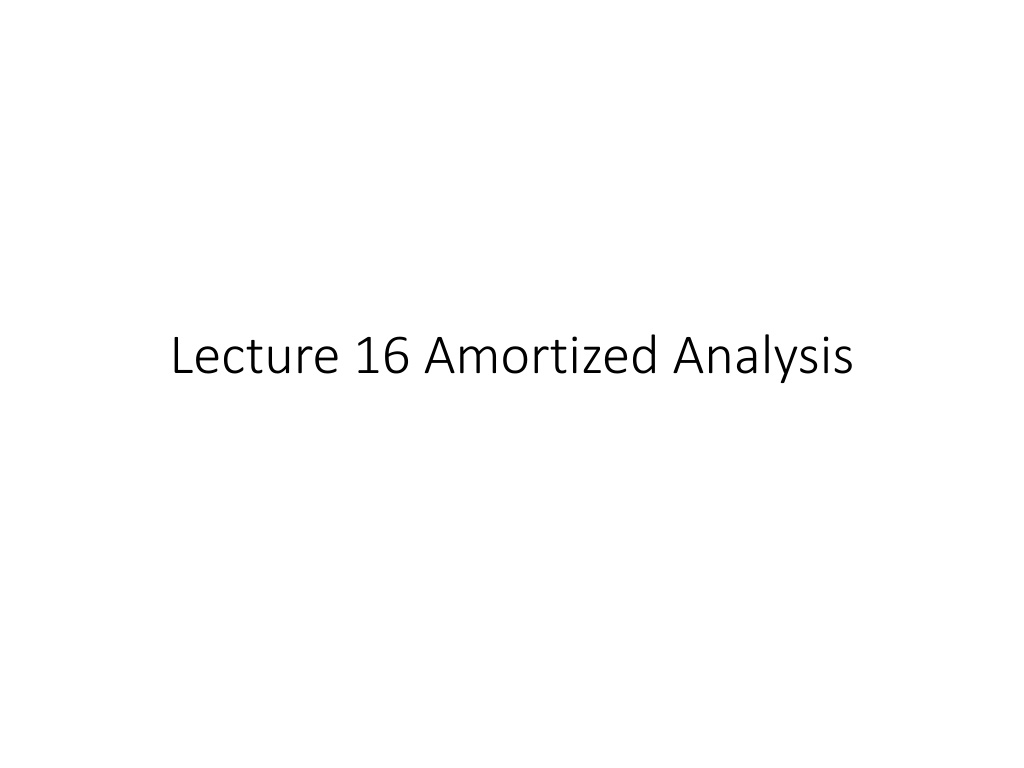
Understanding Amortized Analysis in Algorithms
Explore the concept of amortized analysis, its application in algorithm design, and how it helps in analyzing the average cost of operations over time. Discover examples like Dynamic Array problem and MergeSort in disguise.
Uploaded on | 0 Views
Download Presentation

Please find below an Image/Link to download the presentation.
The content on the website is provided AS IS for your information and personal use only. It may not be sold, licensed, or shared on other websites without obtaining consent from the author. If you encounter any issues during the download, it is possible that the publisher has removed the file from their server.
You are allowed to download the files provided on this website for personal or commercial use, subject to the condition that they are used lawfully. All files are the property of their respective owners.
The content on the website is provided AS IS for your information and personal use only. It may not be sold, licensed, or shared on other websites without obtaining consent from the author.
E N D
Presentation Transcript
Amortized verb (used with object), amortized, amortizing. 1. Finance. to liquidate or extinguish (a mortgage, debt, or other obligation), especially by periodic payments to the creditor or to a sinking fund. to write off a cost of (an asset) gradually. Definition from Dictionary.com
Amortized Analysis in Algorithms Scenario: Operation A is repeated many times in an algorithm. In some cases, Operation A is very fast. In some other cases, Operation A can be very slow. Idea: If the bad cases don t happen very often, then the average cost of Operation A can still be small.
Amortized Analysis in disguise MergeSort Merge(b[], c[]) 1. a[] = empty 2. i = 1 3. FOR j = 1 to length(c[]) 4. WHILE b[i] < c[j] 5. a.append(b[i]); i = i+1 6. a.append(c[j]); j = j+1 7. RETURN a[] For each iteration, steps 4-5 can take different time Worst case: O(n) per iteration O(n2)? The total amount of time 4-5 can take is O(n).
Amortized Analysis in disguise DFS For each vertex, the number of edges can be different. If a graph has m = 5n edges, and there is one vertex connected to n/2 other vertices. Worst case for a vertex: O(n) O(n2)? No: the total amount of time is proportional to the number of edges.
Dynamic Array problem Design a data-structure to store an array. Items can be added to the end of the array. At any time, the amount of memory should be proportional to the length of the array. Example: ArrayList in java, vector in C++ Goal: Design a data-structure such that adding an item has O(1) amortized running time.
Why nave approach does not work a 1 2 3 4 5 6 7 a.add(8) 1 2 3 4 5 6 7 8 Need to allocate a new piece of memory, copy the first 7 elements and add 8. a.add(9) 1 2 3 4 5 6 7 8 9 Need to allocate a new piece of memory, copy the first 8 elements and add 9. Running Time for n add operation = O(n2)!
Designing the Data-Structure We don t want to allocate new memory every time. Idea: when allocating new memory, allocate a larger space. Init() capacity = 1 length = 0 allocate an array a[] of 1 element Add(x) IF length < capacity THEN a[length] = x length = length+1 ELSE capacity = capacity * 2 allocate a new array a[] of capacity elements copy the current array to the new array a[length] = x length = length+1
How to Analyze? There are 3 basic techniques to analyze the amortized cost of operations. Aggregate Method Accounting (charging) method Potential Argument
Aggregate Method Idea: Compute the total cost of n operations, divide the total cost by n. Conceptually simple Can be difficult to compute for more complicated problems. What s used in analyzing MergeSort and DFS.
Accounting (charging) method Idea: Have a bank account (of running time) save money in order to pay for the more expensive operations (old fashioned: no credit card, no interest) Major step: Design a way of charging the expensive operations to the normal operations. Make sure the bank account always have money.
Potential Argument Recall: Law of physics
Potential Argument Define a potential function , 0. When executing an expensive operation, the potential function should drop (Potential turns into energy) When executing a normal (light) operation, the potential function should increase (Energy turns into potential)
Potential Argument Amortized cost of an operation: Suppose an operation took (real) time Ti, changed the status from xi to xi+1 ??= ?? ?? + (??+1) Amortized Cost Potential Before Potential After Real Cost ? ? Claim: ?=1 ??= ?=1 ??+ ?1 (??+1)
